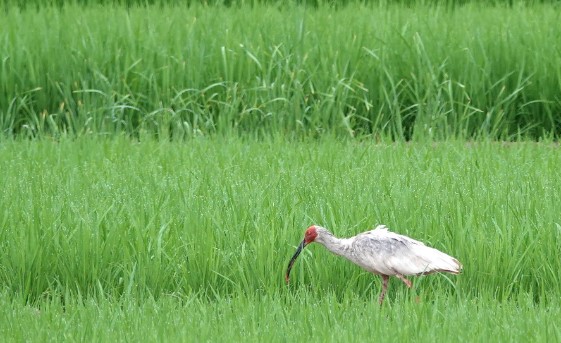Endangered bird species successfully reproduces in Gyeongsan

For the first time in nearly half a century, a pair of crested ibises bred in captivity have successfully reproduced in the wild in Korea ? marking a milestone in the country’s long-running effort to bring the endangered species back from extinction.
The Changnyeong County Office in South Gyeongsang announced on July 2 that three crested ibis chicks had hatched in the wild near Daedae-ri in Yeo-myeon, a rural township in the county. It marks the first successful wild breeding of the species in Korea since it was declared extinct on the peninsula in 1979, and six years after the first release of the birds into the wild in 2019.
The parents of the three chicks were second-generation ibises ? the female hatched in 2022 and the male in 2023. According to the county, the pair mated and built a nest around March, with the three chicks hatching recently. The total number of eggs laid was not confirmed.
“The chicks received about six weeks of care from the mother and have since successfully left the nest,” a county official said. “This successful breeding in the wild highlights Changnyeong County ? home to natural habitats like the Upo Wetlands ? as an ideal location for ibis restoration.”
The crested ibis, a natural monument and listed as a class two endangered species in Korea, once thrived in wetlands and rice paddies, feeding on amphibians like mudfish and frogs. However, habitat destruction led to their disappearance, with the last recorded sighting in the demilitarized zone in 1979.
Breeding efforts began in 2008 with the establishment of the Upo Crested Ibis Restoration Center in Yeo-myeon. The project was launched after China gifted Korea a breeding pair of ibises during a bilateral summit that year. Two more males were donated by Chinese President Xi Jinping in 2013. Since then, a combination of artificial and natural incubation has resulted in the release of 390 ibises into the wild.
Each released bird is fitted with a solar-powered tracking device 63 millimeters (2.4 inches) wide, 35 millimeters long and 14 millimeters high, that records its location every two hours over a two-year period. Drones are also deployed over the Upo Wetlands to monitor the birds and study their movement and behavior to support their reestablishment in the wild.
“The successful natural breeding of wild ibises means that they are now beginning to settle independently in nature,” said Changnyeong County Gov. Sung Nak-in. “We will continue efforts to preserve the natural environment and manage the ecosystem so that the released ibises can thrive.”